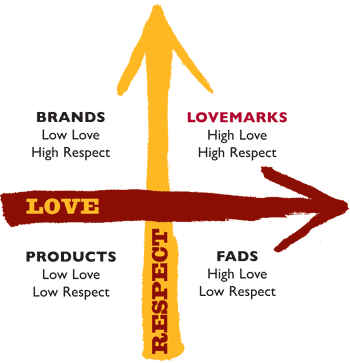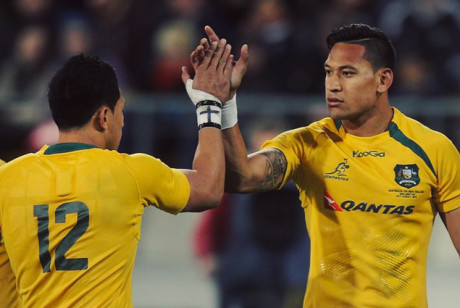Stop! In the Name of Love
Tuesday, 24 September 2002 - Barcelona, Spain

Presentation Summary
An address to the World Association of Research Professionals (ESOMAR). Business has moved from the clichés of consumer focus to the realities of consumer commitment. We must develop ways to measure important human emotions like love, empathy and loyalty. The market research industry gets asked to step up to inspiration, and find ways to get past information, and find meaning.
I guess I may have upset some people when I talked about the now infamous “research vampires”. I’ve left my garlic and wooden stakes at home. I’m here with ideas and solutions.
We do have so much in common. We also have a lot to debate. We have in common a commitment to our clients, a passion for truth and a fascination for ideas.
You’ve put the debate on the table yourselves: “Consolidation or Renewal?” – the theme of this Congress. Business-as-usual or transformation.
When I joined Saatchi & Saatchi five years ago, we issued ourselves a new transforming challenge. To change from the most famous advertising agency in the world to the hottest ideas company on the planet. Our new job? To create emotional connections that deliver loyalty beyond reason.
Your industry needs to transform itself. You have more sophisticated measuring technologies, deeper penetration into businesses everywhere, societies, associations, codes of conduct and plans by the score. But these are the trappings of consolidation, not renewal. Where is the energy and confidence? Where’s the transformation? Are you backing off your real challenges?
Your Challenges
The challenges that face you are the same challenges that face brands. Hardly surprising. Your industry and brands are locked together.
Brands had a dream run pumping the global economy and increasing the complexity and scale of marketing.
But we all face dramatic change. Consumers are changing. Markets are changing. Channels are changing. The location of value is changing. Brands are not immune. They have been commodified. The research industry as their support team is following the same track.
How do you know when your industry is caught in the commodity trap?
- The dreaded ‘ER’ words. Faster, easier, newer and – worst of all – cheaper. This is how you are judged when you slip down the value chain. Eager to give away more for less just to stay in the game. No strategic input, no judgment, low value.
- Good old-fashioned competition. More and more suppliers putting serious pressure on price and on margins. Intense competition makes mergers and acquisitions seem like a great idea. But while consolidation bulks you up, it can hide the real problems.
- Creativity slows to a crawl. The classic sign of a commodity is when everything you do is copied by someone else real fast. The automatic reaction? Protect what you’ve got. A wall of proprietary black boxes and trademarks holding your formulas close. ESOMAR estimates that around 40 percent of the value of your $US15 billion industry is locked into continuous research. No wonder it is so tough to get you to entertain a new idea. You have too much invested in getting as much as you can out of old ones.
- Meaningless specialization. No one stands out. So everyone invents new and “unique” specializations. If clients can’t see a meaningful difference, they are not going to pay premium. And if you spend your time debating the benefits of specific tools and methodologies, you’re in the wrong conversation. ESOMAR sets its members the challenge of “improving decision-making”. An inspiring goal, worthy of anyone’s best efforts. This is where you need to focus. This is where you can add real, sustainable value. This is where what you do matters.
For Saatchi & Saatchi to be a leading ideas company we need your skills and knowledge. Your insights, instincts and intuitions. But we need you as partners, not as judges. We need research we can use. Research that guides and informs our clients’ decision-making. We need your courage and participation, not a score out of ten.
For the past three years I’ve been talking love. At first people were embarrassed. Love had no business in business. But as the pressure has come on, Love no longer seems out of place. The power of Love is being felt everywhere. People no longer fear it.
I call on you to take up these five transforming challenges.
1: Feel Emotion
Emotion is back in vogue. The human brain turned out to more complex, more densely connected and more mysterious than any of us dreamt. But let’s not become wanna-be neurologists and physiologists. You don’t have to be a brain surgeon to get this!
In the grand old brand days emotion was a clip-on. Brands flourished in the rational world of benefits. The ad guys were there to pipe on some emotional icing – and that was that.
Fast-forward to 2002. We now accept that human beings are powered by emotion, not by reason. Emotion and reason are intertwined, but when they conflict – emotion wins every time. Without the fleeting and intense stimulus of emotion, rational thought winds down and slowly disintegrates.
Why should that matter to this congress? Donald Calne puts it like this: “The essential difference between emotion and reason is that emotion leads to action while reason leads to conclusions.” More emotion, more action. More reason, yet more conclusions.
Emotion is an unlimited resource. It controls our rationality, our decision making. It’s always there – waiting to be plugged into. And there are no limits to its power. It is the rainmaker of billion dollar brands.
Current efforts to measure emotion just don’t cut it. They take the frameworks created for the rational mind and try to apply them to the deep mysteries of emotion. No wonder it’s tough to isolate effects. No wonder it’s tough to interpret results.
The changing demands on business point us in the right direction.
Over the last 30 years the shift of power from manufacturers to retailers and distributors has been well documented. But a more radical shift is gathering speed. It’s no longer what businesses agree to give consumers. It is what consumers demand of business.
People want control over their lives. There’s more choice. Higher expectations. Many more touch-points. This is the new consumer. This is way outside the territory of brands. This is where loyalty beyond reason lies.
You have built a global industry backing brands. Nailing their functional benefits. Helping them make incremental improvements. We now need more from you. The stairs from the counting room to the boardroom are paved with emotions. Start climbing.
ESOMAR is working to protect consumer privacy. Why not come together to explore consumer emotion? It makes no sense to measure emotion according to traditional scales. So invent some that do make sense. You have the skills, the resources, the brains. Now is the time to make a serious commitment.
It would be fantastic if at next year’s Congress you had new ideas to share about emotion. The power of emotion throughout business – strategy, marketing, performance, staffing. Integration at this level would deliver real client value. I’d be back to learn from that.
2: Touch Lives
Touching lives is a way out of the commodity trap. Brands can’t make it. Too late for Brand Aid. The reason is buried deep in their history. Procter & Gamble probably spends more on market research than any company in the world. But A G Lafley, the CEO, understands that his giant business has to change fundamentally.
How? By setting out to touch and improve lives. Very little of P&G’s market research investment currently looks forward to this goal. Most of it faces back to the glory days of brands. Like everything else AG is doing at P&G, he’s turning this around too.
Brands evolved in the era of transactions. Getting close enough to touch was never on the agenda. Their roots were in consumption, information, efficiency. Now they cannot stretch far enough from their transactional roots to make emotional connections. Copy testing belongs back there. All those voices asking all those questions in a world unconnected with reality. Listening to these voices will get us all into trouble.
AG said recently: “I don’t think the answers are just in numbers. You have to get out and look.” You can call it ethnographic research. I call it the best way yet to create value. If you want to understand how a lion hunts don’t go to the zoo. Go to the jungle.
We all know that focus groups are a miserable way to understand anything. And we all know why. And yet we can’t seem to leave them behind.
Why not? For a deeply emotional reason. For a brief moment we can touch consumers. Flawed, skewed and inaccurate the results may be, but for that moment real people talking feels true.
ESOMAR is concerned by the growing confusion between market research and direct marketing. Big red light when you get confused with a business proud of being a commodity! And sometimes on the other end of the phone it is hard to tell the difference between you and the other guys.
ESOMAR wants to promote the positive value of research but this only protects what you hold. To go where I believe you need to go, to touch consumers, you need to face a bunch of issues you have avoided so far. How to deal with the rich variety of experience? How to factor in the senses when they use such fine-grained distinctions? How to touch all those crucial emotions and ideas bubbling below the surface of consciousness?
So how about a new platform for the renewal of your industry. Improve decision-making, sure, but now commit to touching lives in all their rich variety. The lives of consumers and customers, your clients and opinion leaders everywhere. Up-front, realistic, actionable. P&G are in touch. Are you?
3: Open up to Ideas
Economist Paul Romer likes to say that big competitive advantages in the marketplace always come from “better recipes, not just more cooking.”
Better recipes demand creativity and new ideas. The ability to synthesize data. The confidence to disrupt and subvert formulas.
The experience to absorb many perspectives – and make sense of them. And then the drive to convince, persuade and illuminate so you can make the right stuff happen.
The management consultancies are getting in on research territory in their usual way. They are on the hunt for partners – or pack horses. Having shed their accountancy functions (just in time) they are telling CEOs they need to directly connect their marketing investments with hard-core financial measures like the share price, return on assets, return on investment, market capitalization. Just what we need. More metric envy.
Value is the idea we should love. More sophisticated ideas of value. A more collaborative sense of how value is created with consumers not through them.
Consumers are at the heart of the enterprise. This insight matters as much to the research industry as it does to businesses themselves. A. G. Lafley puts it succinctly: the consumer is boss. You cannot assert the consumer is boss and then try to control and manage her. You cannot reduce what she shares with you to a statistic.
As businesses head from the cliches of consumer focus to the realities of consumer commitment, the changes needed to make it happen will be immense. How companies organize themselves, how they behave, what is important to them, how they connect global knowledge with local insight.
Now is the time to set your arsenals of tools aside. To put percentage pointlessness behind you. Time to join with people who nurture ideas and can touch people like no one else can. Us – Saatchi & Saatchi. Make us love you!
4: Embrace Lovemarks
Saatchi & Saatchi looked out at the world brands had created and found it cramped and out-dated. There were some great brands but they had gone way past the pack. We had to work out what they had evolved into.
The future beyond brands is Lovemarks. Darwin would have got it right off. Fish to lizard. Monkey to man. Brand to Lovemark. An evolutionary stairway to heaven.
- Lovemarks are a game-breaking opportunity to reinvent branding.
- Lovemarks connect companies, their people and their brands.
- Lovemarks inspire loyalty beyond reason.
- Lovemarks are owned by people, not by companies.
- Lovemarks are the ultimate premium profit generator.
You know a Lovemark instantly. A Lovemark can be local and it can be global; a place, a product, a person, an experience.
- Harley-Davidson, definitely. Suzuki? I don’t think so.
- Here’s an iMac. Here’s a Thinkpad. Sorry IBM.
- McDonald’s. Lovemark. Burger King has got the taste but not the Love.
From the outset we knew that Lovemarks were too big an idea to box up and control. There is no TM, no black box. There never will be. Lovemarks are a work-in-progress. You can be part of the adventure on www.lovemarks.com.
So far we have developed three approaches to work with Lovemarks.
Love and Respect
This Axis is where it all began. One simple insight that has become our fast, intuitive reality check.
Start here with Low Respect and Low Love – classic commodities. Public Utilities. Low value transactions. Essential but going nowhere. Zero brand heat.
Move on to Low Respect and High Love. Fads, trends, infatuations. Last month’s gotta-haves. Next month’s has-beens. Pokemon and shaving patterns into your hair. The Spice Girls and Survivor.
High Respect and Low Love – this is where most major brands are stuck. Functional benefits, solid performance and always fixed on those “e-r” words. The research industry sits right here – with the ever-present risk of slipping.
High Respect and High Love. Lovemarks. This is where new value lies. Here we can create deep connections with customers by building on Respect, but igniting Love.
I talk more about Love than Respect because we all do Respect so much better. Huge investments have been made in it for decades. They are what you built your businesses on. Love now demands the same rigour.
Toyota gets it. We’ve been working with them on Lovemarks for two years now. Don Esmond at Toyota USA crystallized the new Toyota challenge: “It’s time to move from the most respected car company in America to the most loved.” That would put Toyota right here: High Love and High Respect. A Lovemark.
Lovemarks want it all. Forget the simplicity of either/or. In our complex world it’s and/and. Love and Respect. Heart and Mind. Emotion and Reason. Quantitative and Qualitative. Local and global. And, and, and.
The DNA of Lovemarks
Lovemarks are brands infused with Mystery, Sensuality and Intimacy. This is the DNA of a Lovemark. This is the Love Triangle. Mystery, Sensuality and Intimacy. All the stuff that is hardest to calculate and measure wrapped together. All the stuff that matters to consumers. Remember Lovemarks are owned by people – not by companies. What matters to them, matters most.
Mystery to draw together the stories, metaphors, dreams and symbols that give a relationship its texture.
Sensuality to enthrall the emotions. Vision, sound, hearing, touch, taste. This is how we experience the world.
And the warm breath of Intimacy. Empathy, commitment and passion. The intimate connections that today no one takes for granted.
The Lovemarker
The elements that create the Mystery, Sensuality and Intimacy of a Lovemark put consumers at the center Each is approached from the customer point of view. What comes through to them, not what marketers intend.
WE created the Lovemarker to generate new insights for instant improvements as well as for fundamental strategy. To anticipate what’s coming up. To make smart judgments. To make the best decision.
With it you can cut through assumptions and rules.
The top people in any business get Lovemarks real fast. But people further down are not so sure. They want a bullet-proof process with tables, diagrams and lots of numbers. They can support their decisions – even if they are wrong.
We took on the challenge of creating Lovemark ways of working with Toyota – one of our two biggest global clients. We developed a Lovemarks audit framework.
The idea is simple. Marketing today means information. Huge volumes of information. Often collected for a specific purpose, it is used once and then … filed. And as for those fascinating facts and figures, fragments and stories that no one knows what to do with. Used as an anecdote and then … lost.
Our Toyota team wondered – What if we approached all this information with a distinctive point of view? What if we could put together the most detailed metrics with the most stunning insights? What if we could organize subjectivity? What if we could draw on information across organisational divides? What if we could get past information and find meaning? And do it all in a Lovemarks framework.
The Lovemarks audit is growing into a powerful strategic tool. We tested it in Australia with Toyota last month. We are planning to roll it out from Paris into Europe.
Lovemarks launch a profound challenge to the research industry. Tools and processes are not primary. They come out of understanding consumers and the business problem – not from a toolbox in your store-room. Learn how to capture Mystery, Sensuality and Intimacy where ever they show themselves. Marry it with Respect. And ensure that how you do the research is itself a Lovemark
A new baby has arrived. Share the love or resign yourselves to being put out the back-door with the cat.
5: Step up to Inspiration
The challenges I believe the research industry must grapple with are huge ones. But there’s more. You must renew and transform yourselves and your organisations. You need to mobilize resources around inspiring ideas.
I have been working with a couple of academic colleagues on three questions that go to the heart of long-term organisational success. No need for a questionnaire. Ask yourself:
How do you inspire your people to care passionately about what they do?
How do you keep getting better when you are already the best?
How do you inspire your people to be the best they can be?
How do you respond to extreme pressure?
We found the answers where there is no place to hide. The tough world of elite professional sport. The story is told in our book “Peak Performance” but for today, just a few high points.
Peak Performance is not just about management and doing things right. It’s not just about leadership and doing the right things. What makes a difference now is inspiration. Inspiration turns up the heat. Awakens people to action. Makes your organisation special and loved. Then you can aspire to becoming a Lovemark.
Peak Performance has a detailed methodology, an evolved everyday language and a track record of major success at transforming organizations. The ten steps pivot around the term Inspirational Player – who here wouldn’t love to be an inspirational player!? You’ll hear about the “greatest imaginable challenge,” the inspirational dream”, the focus; family, sharing the dream, creating the future, game-breaking ideas…read the book, check out my websites saatchikevin.com and Lovemarks.com for the lowdown on the high ground of Peak Performance.
Only with passion, inspiration and emotion can people become great creatives, great researchers, great entrepreneurs, great players.
Over the past four years we have been transforming Saatchi & Saatchi from an advertising agency into an Ideas Company. From a collection of offices around the world into a Peak Performing Organization. The transformation of our people from effective leaders into passionate inspirers. Our clients from brand leaders into Lovemarks.
Procter & Gamble have picked up the challenge. AG has committed to unleash his Inspirational Players as a Number 1 priority. To move from command and control to unleash and inspire. With my colleagues I run two-day workshops each quarter with selected P&G Inspirational Players. AG leads each session with me. It’s a big commitment but the impact is immediate on any Inspirational Player.
Saatchi & Saatchi is an ideas company so I’ll end with some ideas pushing past consolidation and towards transformation.
Give your brains a rest. Nothing wrong with thinking – but thinking demands action to make any sense. You can’t think your way into relationships, insights, great ideas. You have got to create them, have them, do them. Love them.
Put consumers up-front and centre. Don’t set them as the default and move on. Value them. Listen to them. Remember them. They light the path to your future.
Trust your judgment. It is a great gift. But remember you need the head and the heart. No point in going out the window with the figures if your gut instinct is telling you to stay.
Get intimate with Lovemarks. Not just comfortable. Intimate. Play with the ideas, don’t polish them. Talk back to us. Start new conversations.
Finally, be an Inspirational Player. Step up. Be a force for good. Make a difference. Touch someone!










